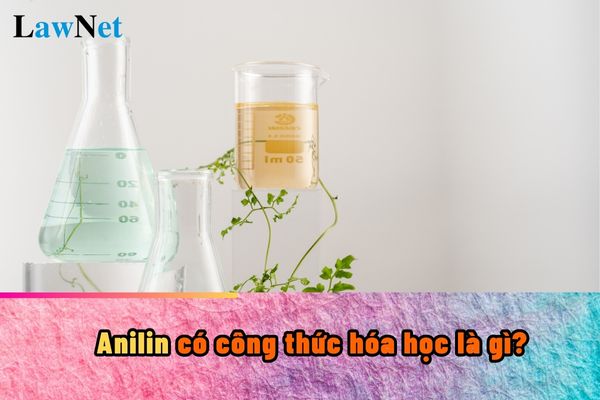What is the chemical formula of Aniline? Is being able to write the chemical formula an indication of chemical proficiency according to the curriculum in Vietnam?
What is the chemical formula of Aniline?
The chemical formula for aniline is:
C₆H₅NH₂.
Aniline is an organic compound belonging to the homologous series of aromatic amines, with an amino group (-NH₂) directly bonded to the benzene ring.
*Alternative names: Phenylamine, benzenamine.
Physical properties: A colorless liquid with a characteristic smell, slightly soluble in water but well soluble in organic solvents.
Chemical properties: Aniline displays both weak base properties (due to the unshared electron pair on the nitrogen atom) and aromatic properties of the benzene ring. It participates in many important chemical reactions, such as substitution reactions on the benzene ring, salt formation reactions, polymerization reactions, etc.
Applications: Aniline is widely used in the chemical industry for producing dyes, pharmaceuticals, antioxidants, rubber stabilizers, and more.
*Note: The information for reference purposes only./.

What is the chemical formula of Aniline? Is being able to write the chemical formula an indication of chemical proficiency according to the curriculum in Vietnam? (Image from the Internet)
Is being able to write the chemical formula an indication of chemical proficiency according to the curriculum in Vietnam?
According to Section 3 of the Natural Sciences Curriculum at upper secondary school level issued with Circular 32/2018/TT-BGDDT, the specific competencies to be achieved are as follows:
Understanding basic knowledge about structural chemistry; chemical processes; forms of energy and energy conservation; some basic chemical substances and chemical transformations; some applications of chemistry in daily life and production. Specific manifestations include:
- Identifying and naming objects, events, concepts, or chemical processes.
- Describing events, characteristics, roles of objects, concepts, or chemical processes.
- Depicting objects by speaking, writing, formulas, diagrams, charts, tables.
- Comparing, categorizing, selecting objects, concepts, or chemical processes based on different criteria.
- Analyzing aspects of objects, concepts, or chemical processes according to certain logic.
- Explaining and arguing the relationship between objects, concepts, or chemical processes (structure - property, cause - effect, etc.).
- Finding keywords, using scientific terms, connecting information meaningfully, drafting outlines when reading and presenting scientific documents.
- Discussing, making critical judgments related to the subject.
Thus, being able to write a chemical formula is one of the manifestations of chemical competency.
What are the four perspectives in developing the Chemistry curriculum in Vietnam?
Pursuant to Section 2 of the Appendix on the Natural Sciences Curriculum at upper secondary school level issued with Circular 32/2018/TT-BGDDT, the four perspectives in developing the Chemistry curriculum at upper secondary school level are as follows:
The Chemistry curriculum adheres fully to the regulations set out in the Overall Program while emphasizing the following perspectives derived from the nature of the subject:
[1] Ensuring Continuity and Development
+ The Chemistry curriculum inherits and enhances the strengths of the existing program, learns from the curriculum development experiences of countries with advanced education systems globally and regionally; at the same time embraces educational science and chemistry advancements suitable for students' cognitive levels and psychological age, considering Vietnam's economic and social conditions.
+ The Chemistry curriculum inherits and develops educational content from the Natural Sciences subject at the lower secondary level through concentric structure combined with linear structure to expand and deepen students’ knowledge and skills. At the lower secondary level, through Natural Sciences, students are introduced to basic chemistry knowledge at a qualitative, visually descriptive level. At the upper secondary level, Chemistry focuses on equipping students with fundamental chemistry knowledge regarding the structure, properties, and applications of elements and compounds, enabling them to explain the nature of chemical transformations at the necessary level.
[2] Ensuring Practical Relevance
The Chemistry program emphasizes practical relevance; avoids a bias towards calculations; focuses on equipping students with key concepts and tools methods, especially helping students develop skills in laboratory practices and applying chemical knowledge to understand and address certain real-world problems, meeting life’s demands.
[3] Implement Career Orientation Requirements
The Chemistry curriculum embodies career orientation education goals. Based on identifying career fields and technological processes requiring in-depth chemistry knowledge, the curriculum selects core educational content and study modules that help students explore chemistry knowledge with many practical applications, aiding career orientation.
[4] Promote Student Activeness
The educational methods within the Chemistry curriculum contribute to promoting students' activeness, creativity, and initiative, aiming to form chemical competency and contribute to forming, developing core qualities and general competencies mandated in the Overall Program.

